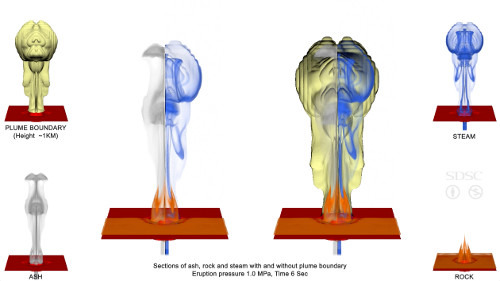Snapshots of a Volcano Eruption Simulation

Eruptive conduits feeding volcanic jets and plumes are connected to the atmosphere through volcanic vents that, depending on their size and 3D shape, can alter the dynamics and structure of these eruptions. The host rock comprising the vent, in turn, can collapse, fracture, and erode in response to the eruptive flow field. These visualizations illustrate results from fully coupled numerical simulations of high speed, multiphase volcanic mixtures erupting through erodible, visco-plastic host rocks. This work explores the influence of different host rock rheologies, computational approximations, and eruptive conditions on the development of simulated volcanic jets.
The movies show the dependence of lithic segregation in the plume on eruption pressure. Host rock and erupted ash mix into the center of eruptions with moderate to low pressure, i.e., less expansion. Host rock is entrained into the outer regions of eruptions with higher pressure, and fine ash mixes throughout the column.
| Image | Image(s) courtesy of Amit Chourasia, Visservices, SDSC/UCSD, Darcy Ogden, SIO/UCSD |
| Data | Data courtesy of Darcy Ogden and Ken Wohletz, LANL. Simulated with CFDLib software (Theoretical Division, LANL). This work was supported by funding from Geophysics and Planetary Physics, LANL and NSF OCI-0503944 |
Previous Post in EXAMPLES Back to EXAMPLES Next Post in EXAMPLES